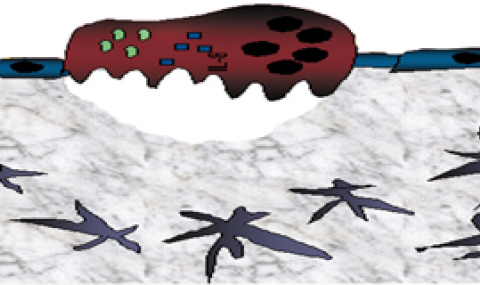Lifelong production of blood by hematopoietic stem and progenitor cells (HSPC) depends on stem cells self-renewal and their maintenance by bone marrow (BM) microenvironment. BM chemotherapy or whole body irradiation frequently causes hematological abnormalities in cancer patients. HSC within the BM exhibit quiescent state with low mitochondrial reactive oxygen species (ROS) and membrane potential, however upon stress hematopoiesis HSC exit quiescence and either self-renew or differentiate in mature cells. Understanding the mechanism controlling hematopoiesis regeneration upon replicative stress is expected to provide molecular targets for amelioration of chemotherapy induced toxicity. Mitochondria recognize and respond to many stress by modifying mitochondrial dynamics and macroscopic autophagy (mitophagy), and maintains HSC function both at intrinsic and extrinsic level (Ho et al., Nature 2017). Upon myeloablative stress, hematopoietic Connexin 43 (H-Cx43) preserves HSPC survival and efficient blood formation by transfer of damaging excess ROS to BM stromal cells (BMSC), preventing HSC apoptosis and lethal hematology failure (Taniguchi-Ishikwawa E et al., PNAS 2012), and its intermediate C-loop domain has been shown to act as negative regulator of the beclin complex of microautophagy (Eloy Bejarano et al, Nat Cell Biol. 2014). Since HSC apoptosis depends on mitochondrial activation and mitochondrial homeostasis is maintained by coordinated regulation of mitochondrial fission/fusion and macro-autophagy (mitophagy), we hypothesized that mitochondrial Cx43 may exert a cell-autonomous activity over the mitochondrial turnover upon cell division in the regeneration phase after myelotoxic chemotherapy. To analyze the role of Cx43 in HSC mitochondrial dynamics and fate, we created HSC mitochondrial reporter mice by crossing Cox8 mitochondrial signal localization peptide-Dendra2 fusion protein transgenic (mito-Dendra2) mice with Vav-Cre; Cx43f/f (H-Cx43mice. While quiescent Cx43 HSC do not demonstrate any major phenotype, snapshot high resolution microscopy demonstrated that Cx43 deficiency enhances mitochondrial superoxide levels, membrane potential and results in larger mitochondria accumulation (~2 fold) after forced division of HSC. In addition, time lapsed cinematography of red-fluorescent, photo-converted mito-Dendra2 demonstrated that Cx43-deficient mitochondria in cycling HSC split into multiple smaller fragments. Phosphorylation of Drp1 (Ser616) and its accumulation with mitochondria is higher in dividing Cx43HSC, suggesting that Cx43 is a negative regulator of mitochondrial fission and its deficiency facilitates mitochondrial fragmentation. Inhibition of mitochondrial fission with overexpression of the dominant-negative Drp1 mutant (K38A) or the Drp1 inhibitor Mdivi1 prevents the effect of Cx43 deficiency on mitochondrial hyper-fragmentation. The fate of the smaller fragments is mitophagy as demonstrated by increased co-localization of Cx43 deficient mitochondria with the ubiquitin kinase PINK1, the autophagy reporter’s p62 and LC3 punctae, and the lysosomal membrane proteins Lamp1/2 in HSC. Genetic silencing of Atg7 or addition of the autophagolysosome inhibitor bafilomycin A1 to dividing HSC prevents the induction of mitophagy in dividing Cx43 HSC. Overexpression of structure-function mutants in Cx43 HSC (Cys-less, with 6 point mutations in Cysteine residues replaced by Alanine, resulting in impaired connexin-to-connexin docking or the truncated C-terminus mutant 257 resulting in impaired signaling and intramolecular interactions needed for channel gating) demonstrated that both the externalized cysteine docking domain and the C-terminus of Cx43 are indispensable for the negative regulatory role of Cx43 on mitophagy and suggests that mitophagy homeostasis requires the docking of two connexin molecules from interacting intracellular membranes and a pore gating structure using the C-terminus of Cx43. Our results thus identify gap junction protein Cx43 as an important regulator of mitochondrial fission and mitophagy in dividing HSC which may be target to preserve hematopoietic stem cell regenerative capacity.

Dynamic Networking between Stem Cells & Bone Marrow Microenvironment


